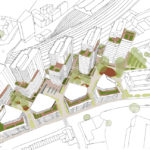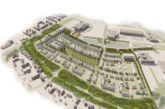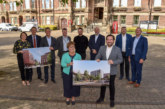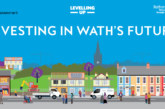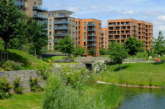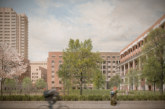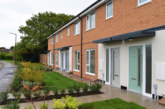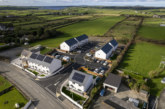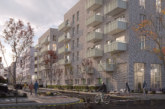 Richard Hyams, Director at astudio, discusses the benefits of unlocking public spaces.
Richard Hyams, Director at astudio, discusses the benefits of unlocking public spaces.
As lockdowns around the world gradually begin to ease, footfall on our high streets slowly increases, workers begin to contemplate returning to the office and schools reopen their doors, many of us are beginning to appreciate the role public spaces can play in fostering – or indeed compromising — public safety.
In fact, COVID-19 has prompted a major rethink of urban planning and design, calling on architects, planners and policy makers to work together to build spaces that prioritise health and safety not just for the post-pandemic period, but also for the many decades to come. Critically, these ‘safer’ spaces not only prioritise public health, but also take us one step closer to a public realm that is more environmentally efficient.
People-centric spaces
Prolonged lockdowns around the globe have reminded many of us of the value of public spaces. Rather than driving this shift, COVID-19 has increased existing support for it, with a multitude of initiatives in recent years creating people-centric spaces in cities across the world. Paris, for example, rebuilt Place de la Republique to give the once traffic-filled space back to the public. Similarly, in Moscow, parts of the city’s Ring highway were turned into city gardens, allowing pedestrians to ‘reclaim’ space.
However, there’s no doubt that this shift has been significant accelerated by COVID-19, with cities across the world paving new spaces for pedestrians and physical activity during and after lockdowns. For example, in Bogota Colombia, the city has added 80km of emergency bike lanes to promote a safer ecosystem for health and transportation. Meanwhile Manchester has announced a £23m investment in the first public realm project in over a century.
Such initiatives have won overwhelming public support. Indeed, a recent poll from YouGov and Greenpeace shows that 58% people support the introduction of cycle lanes in urban areas, and a further 55% of Londoners supporting the reallocation of government construction funding to better walking and cycling spaces. For innovative practices like astudio, a recognition of the importance of outdoor spaces in our lives, both during lockdown and beyond, has prompted us to expand our expertise to provide landscape design services with the growth of a new landscape team.
Making use of the great outdoors
With shoppers, workers and diners beginning to return to public spaces in towns and cities across the world, de-densifying to foster safety and social distancing will be a priority for local communities. While, this does present a challenge, maximising the use of outdoor areas and relocating trading to civic spaces or parks presents a promising solution.
Councils can enable this by providing permits that allow trading to take place outside of their physical shops. For example, Southampton’s ‘inside out’ initiative allows more businesses to extend their outside seating areas, with a three-month permit for just £50. On a larger scale, Lithuanian capital Vilnius has turned the city into an ‘open-air café’ and art exhibition to accommodate social distancing, maximise hospitality job retention and retain the city’s identity as a place of culture.
However, to deliver public realms that are truly fit for purpose and fulfil people’s needs, landscape and building design must be closely tied. For instance, across astudio’s Ebury Bridge Estate regeneration project in the heart of Westminster, which has recently been submitted for planning permission, the public space has been tested and modelled, using environmental testing software, alongside the development of the buildings. This will deliver improvements to daylight quality at peak times of year, as well as uplifting the external space in comparison to the existing site.
Digital de-densification
Of course, architects and planners do face a unique challenge in ensuring safe and social distanced public spaces, where buildings, footfall routes and other communal areas cannot easily be augmented. Indeed, scattered across the UK and Europe are historic towns and cities with narrow streets and entryways that are prime sites for overcrowding — a long-term problem, not simply a challenge in the era of social distancing.
Designers and planners can look to technology to help, where innovations including Virtual Reality and parametric design allow them to visualise the space and test different scenarios. The data that these technologies use can assess different considerations including population density, sunlight and air quality to maximise the safety of public spaces and inform the next generation of post-pandemic urban planning.
Social distancing supports sustainability
The benefits of regenerating public spaces in urban areas not only support public health, but also help to create local jobs, support small businesses and get workers back to the office, leading to stronger economies in the longer term. But importantly, such changes can also deliver positive change to the sustainability of our public spaces.
With air quality high on the agenda in the wake of COVID-19, for example, our future towns and cities must be planned with strategies to prevent air pollution and toxicity in mind by prioritising spaces for people and reducing the volume of traffic. Initiatives to promote environmentally friendly modes of transport, such as walking and cycling paths, also helps to minimise the use of vehicles and foster greener, healthier practices for the long-term benefit of our communities.
Now is the time to be ambitious
We have already seen the beginnings of a movement to deliver public-centred projects in cities and towns across the world as officials recognise its value in contributing to community health, our environment and the economy. For instance, astudio’s Ebury Bridge Estate project exemplifies the importance of designing a high-quality public space that is multi-use and flexible in its nature. In addition to providing approximately double the number of much needed homes on site, the new project improves the quantum and quality of external space quantum through intelligent design, environmental modelling, digitally enabled testing.
With these foundations already in place, now is the time to be ambitious. By delivering people-focused spaces, making use of the outdoors, leveraging the latest in planning technology, we can deliver spaces that are not only safer post-COVID-19, but environmentally greener too.

